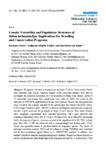Por favor, use este identificador para citar o enlazar este ítem:
http://www.alice.cnptia.embrapa.br/alice/handle/doc/1013073Registro completo de metadatos
| Campo DC | Valor | Lengua/Idioma |
|---|---|---|
| dc.contributor.author | ERBANO, M. | pt_BR |
| dc.contributor.author | SCHUHLI, G. S. e | pt_BR |
| dc.contributor.author | SANTOS, É. P. dos | pt_BR |
| dc.date.accessioned | 2015-04-09T11:11:11Z | pt_BR |
| dc.date.available | 2015-04-09T11:11:11Z | pt_BR |
| dc.date.created | 2015-04-09 | pt_BR |
| dc.date.issued | 2015 | pt_BR |
| dc.identifier.citation | International Journal of Molecular Sciences, v. 16, p. 7839-7850, 2015. | pt_BR |
| dc.identifier.uri | http://www.alice.cnptia.embrapa.br/alice/handle/doc/1013073 | pt_BR |
| dc.description | The genetic diversity and population structure of Salvia lachnostachys Benth were assessed. Inter Simple Sequence Repeat (ISSR) molecular markers were used to investigate the restricted distribution of S. lachnostachys in Parana State, Brazil. Leaves of 73 individuals representing three populations were collected. DNA was extracted and submitted to PCR-ISSR amplification with nine tested primers. Genetic diversity parameters were evaluated. Our analysis indicated 95.6% polymorphic loci (stress value 0.02) with a 0.79 average Simpson?s index. The Nei-Li distance dendrogram and principal component analysis largely recovered the geographical origin of each sample. Four major clusters were recognized representing each collected population. Nei?s gene diversity and Shannon?s information index were 0.25 and 0.40 respectively. As is typical for outcrossing herbs, the majority of genetic variation occurred at the population level (81.76%). A high gene flow (Nm = 2.48) was observed with a correspondingly low fixation index. These values were generally similar to previous studies on congeneric species. The results of principal coordinate analysis (PCA) and of arithmetic average (UPGMA) were consistent and all three populations appear distinct as in STRUCTURE analysis. In addition, this analysis indicated a majority intrapopulation genetic variation. Despite the human pressure on natural populations our study found high levels of genetic diversity for S. lachnostachys. This was the first molecular assessment for this endemic species with medicinal proprieties and the results can guide for subsequent bioprospection, breeding programs or conservation actions. | pt_BR |
| dc.language.iso | eng | eng |
| dc.rights | openAccess | eng |
| dc.subject | Salvia lachnostachys | pt_BR |
| dc.subject | Variabilidade genética | pt_BR |
| dc.subject | Estrutura populacional | pt_BR |
| dc.subject | Melhoramento genético | pt_BR |
| dc.subject | Intraspecific diversity | pt_BR |
| dc.subject | ISSR | pt_BR |
| dc.subject | Labiatae | pt_BR |
| dc.title | Genetic variability and population structure of Salvia lachnostachys: implications for breeding and conservation programs. | pt_BR |
| dc.type | Artigo de periódico | pt_BR |
| dc.date.updated | 2015-04-09T11:11:11Z | pt_BR |
| dc.subject.thesagro | Conservação | pt_BR |
| riaa.ainfo.id | 1013073 | pt_BR |
| riaa.ainfo.lastupdate | 2015-04-09 | pt_BR |
| dc.identifier.doi | 10.3390/ijms16047839 | pt_BR |
| dc.contributor.institution | Marianna Erbano, Pós-graduanda da UFPR; GUILHERME SCHNELL E SCHUHLI, CNPF; Élide Pereira dos Santos, UFPR. | pt_BR |
| Aparece en las colecciones: | Artigo em periódico indexado (CNPF)  | |
Ficheros en este ítem:
| Fichero | Descripción | Tamaño | Formato | |
|---|---|---|---|---|
| 2015APIGuilhermeSGeneticVariability.pdf | 1,93 MB | Adobe PDF |  Visualizar/Abrir |









